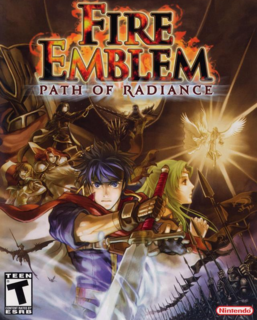Fire Emblem: Path of Radiance takes Nintendo's classic strategy RPG series to the GameCube with plenty of style.
Path of Radiance focuses on Ike, a young mercenary in a company run by his father. The game starts off quietly with the player stepping into Ike's shoes and spending the first few chapters becoming acquainted with the nuances of the battle system. However, it's not long before the neighboring nation of Daein attacks Ike's homeland, a princess is rescued, and the real challenges begin. The level of difficulty that the game presents ramps up smoothly, and with three different difficulty settings to choose from, series newcomers and veterans both should feel comfortable. Path of Radiance also includes an excellent selection of optional tutorials related to just about every subject, so help is always just a couple of button presses away.
Path of Radiance includes a couple of gameplay features that are brand new to the series. The first is a "shove" command, which essentially allows larger characters to push smaller ones to the next space over and creates a new layer to the game's already complex strategy. The other major new feature is the laguz. Laguz units are shape-shifting characters that switch back and forth between combat incapable humanoid forms and high-powered animal forms. Their transformations are controlled by a gauge that fills and depletes over time, so the key to using them effectively is to send them to the front lines when in beast form and have them pull back just before they change back. The inclusion of these units is also well-handled, as their tremendous strengths are balanced out by their weakness to certain weapons and magic that prevents them from being too overpowering in their beast forms.
Beyond these new features and a few other tweaks, Path of Radiance still subscribes to the same classic gameplay formula that the series is known for, featuring turn-based character movement and battles. As in the previous games, all of the player's characters are unique personalities, and should they die, they'll be gone forever. Players that want to make it through the game with a complete roster will need to make careful decisions on the battlefield, as well as memorize the GameCube's soft reset function (Start+B+X); like in the previous games, Path of Radiance doesn't allow hard saves during battle.
As previously noted, Fire Emblem has taken its first step into the realm of three-dimensional graphics with Path of Radiance. The high points come in the form of FMV sequences that punctuate a few key moments in the game's story. The look of these sequences is accented by an effective use of cell shading, and they all feature good use of voice acting. In the game itself, the maps and in-battle characters are all character models that aren't as detailed, but all of the figures are colorful and very easy to distinguish. Outside of battle, characters are represented by the same sort of large, well-illustrated character portraits that were present in the GBA titles. The only really disappointing feature about the game's graphics and sound is the lack of vocal dialogue outside of the FMV sequences. Path of Radiance features a copious amount of text; something that shouldn't come as a shock to fans of the series, but would have been nice to hear some more of the characters' voices.
On the other hand, Path of Radiance features plenty of music, and the tracks switch up often enough that there is plenty of variety. The GameCube obvously provides much greater sound support than the GBA, and for the music, it doesn't go to waste. Upon beating the game for the first time, a sound room featuring the game's entire soundtrack is opened, allowing players to listen to any particular song at leisure.
Among other extras, Path of Radiance also includes bonus "trial maps." Players can use their character data from the end of the game and tackle these new challenges. There are six trial maps in all. Three of them are unlocked by playing the game (one map per difficulty level), but the other three are only available to those that import data from the GBA titles Fire Emblem and Fire Emblem: The Sacred Stones using a GBA and a GameCube cable. If you already own the games and have the ability to upload the data, the extra maps are some of the most challenging in Path of Radiance, but they aren't necessary to enjoy the maps unlocked for simply beating the game.
Fire Emblem: Path of Radiance should take the average player roughly 35 to 40 hours to complete, but there are plenty of reasons to replay the game once you've beaten it the first time. The support conversation feature makes a return, now streamlined so that you can read them while at base in between battles, and although it's not possible to read every last one of them in one playthrough, they're highly entertaining and often provide insights into the characters that aren't available in the normal course of the story. For the more dedicated players, multiple playthroughs will eventually yield bonus characters for use on the trial maps. However, the most compelling reason to play through the game more than once is that the strategic aspect of the game is open-ended enough that there are numerous ways to play through the game and a whole multitude of characters to experiment with.
For GameCube owners looking for a good strategy RPG, Fire Emblem: Path of Radiance is probably the only option readily available, but that shouldn't take away from the fact that it is still an excellent game. Path of Radiance is the best Fire Emblem game yet. Fans of the series and anyone looking for a deep tactical RPG with an intriguing storyline should find plenty to love.

